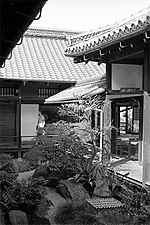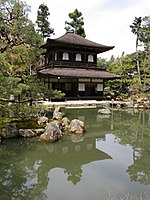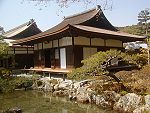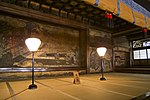The term "National Treasure" has been used in Japan to denote cultural properties since 1897.[1]The items are selected by the Ministry of Education, Culture, Sports, Science and Technology based on their "especially high historical or artistic value".[2][3] This list presents 14[nb 1] entries of residential structures from 15th-century feudal Muromachi period to the early modern 17th-century Edo period. The structures listed include teahouses, shoin, guest or reception halls and other rooms which are part of Japanese domestic architecture, while most of the structures are located in temples, one is a castle.[3] In 2009, the early 20th century Akasaka Palace was designated as National Treasure in the category of "modern residences" (Meiji period and later). Because it is the only National Treasure in this category, it is listed together with the 14 pre-Meiji period structures.[4]

The foundations for the design of today's traditional Japanese residential houses with tatami floors were established in the late Muromachi period and refined during the ensuing Momoyama period.[5][6] Shoin-zukuri, a new architectural style influenced by zen Buddhism, developed during that time from the shinden-zukuri of earlier Heian period palaces and the subsequent residential style favored by the warrior class during the Kamakura period.[5][7][8] The term shoin (書院), meaning study or drawing room, has been used to denote reception rooms in residences of the military elite as well as study rooms at monasteries.[5][9] A shoin has a core area surrounded by aisles, with smaller areas separated by fusuma sliding doors, or shōji partitions constructed of paper on a wooden frame or wooden equivalents, mairado (舞良戸) and sugido (杉戸).[7] A main reception room is characterized by specific features: a recessed alcove (tokonoma); staggered shelves; built-in desks; and ornate sliding doors.[5][7] Generally the reception room is covered with wall-to-wall tatami, has square beveled pillars, a coved and/or coffered ceiling, and wooden shutters protecting the area from rain (雨戸, amado).[5][7] The entrance hall (genkan) emerged as an element of residential architecture during the Momoyama period.[7] The oldest extant shoin style building is the Tōgu-dō at Ginkaku-ji from 1485. Other representative examples of early shoin style, also called shuden, include two guest halls at Mii-dera.[10] In the early Edo period, shoin-zukuri reached its peak and spread beyond the residences of the military elite.[6] The more formal shoin-style of this period is apparent in the characteristics of Ninomaru Palace at Nijō Castle as well as the shoin at Nishi Hongan-ji.[6][11]
The simpler style used in the architecture of tea houses for the tea ceremony developed in parallel with shoin-zukuri. In the 16th century Sen no Rikyū established dedicated "grass hut" (草庵, sōan) style teahouses characterized by their small size of typically two to eight mat, the use of natural materials, and rustic appearance.[12] This teahouse style, exemplified by the Jo-an and Tai-an teahouses, was influenced by Japanese farmhouse style and the shoin style[13] featuring tatami matted floors, recessed alcoves (tokonoma) and one or more ante chambers for preparations.[13]
By the beginning of the Edo period, the features of the shoin and the teahouse styles began to be blended.[14] The result was an informal version of the shoin style, called sukiya-zukuri (数寄屋造).[15][16] Sukiya-zukuri has the characteristic decorative alcove and shelf, and utilizes woods such as cedar, pine, hemlock, bamboo, and cypress, often with rough surfaces including the bark.[16] Compared to shoin style, roof eaves in the sukiya style bend downward.[15] While the shoin style was suitable for ceremonial architecture, it became too imposing for residential buildings. Consequently, the less formal sukiya style was used for the mansions of the aristocracy and samurai after the beginning of the Edo period.[16][17]Examples of sukiya style architecture are found at the Katsura Imperial Villa and the Black Study Hall of Nishi Hongan-ji.
Statistics
In total there are 15[nb 1] structures at ten compounds in five cities.[nb 2] Ten of these structures are located in Kyoto. The compound with most National Treasures of the residential building category is Nishi Hongan-ji, with three structures.[18]

| Prefecture | City | National Treasures |
|---|---|---|
| Aichi | Inuyama | 1 |
| Kyoto | Kyoto | 10[nb 1] |
| Ōyamazaki | 1 | |
| Shiga | Ōtsu | 2 |
| Tokyo | Tokyo | 1[nb 2] |
| Compound | National Treasures |
|---|---|
| Ninomaru Palace (Nijō Castle) | 1[nb 1] |
| Nishi Hongan-ji | 3 |
| Ginkaku-ji | 2 |
| Mii-dera | 2 |
| Sanbō-in | 2 |
| Ryōkō-in (Daitoku-ji) | 1 |
| Myōki-an | 1 |
| Tō-ji | 1 |
| Urakuen | 1 |
| Akasaka Palace | 1[nb 2] |
| Period[nb 3] | National Treasures |
|---|---|
| Muromachi period | 2 |
| Momoyama period | 7 |
| Edo period | 5[nb 1] |
| Meiji period | 1[nb 2] |
Usage
The table's columns (except for Remarks and Image) are sortable pressing the arrows symbols. The following gives an overview of what is included in the table and how the sorting works.
- Name: name of the structure as registered in the Database of National Cultural Properties[3][nb 1]
- Compound: name of the compound in which the structure is located
- Remarks: architecture and general remarks including:
- size measured in meters or ken (distance between pillars); "m × n" denotes the length (m) and width (n) of the structure, each measured in ken
- architectural style (zukuri) and type of roofing
- Date: period and year of the construction; The column entries sort by year. If only a period is known, they sort by the start year of that period.
- Location: "town-name prefecture-name" and geo-coordinates of the structure; The column entries sort as "prefecture-name town-name".
- Image: picture of the structure; If the image shows more than one structure, the respective structure is indicated by a blue rectangle.
Treasures
| Name | Compound | Remarks | Date | Location | Image |
|---|---|---|---|---|---|
| Jo-an (如庵)[19] | Uraku-en (有楽苑) | Japanese teahouse, single-storied, irimoya style[ex 1] with shake roof, chashitsu with 2.5 + 3/4 mat and a three mat mizuya, built by Oda Uraku, a disciple of Sen no Rikyū | early Edo period, c. 1618 | Inuyama, Aichi 35°23′16.66″N 136°56′31.35″E / 35.3879611°N 136.9420417°E |  |
| Kangakuin Guest Hall (勧学院客殿, kangakuin kyakuden)[21] | Mii-dera | 7 × 7, irimoya style,[ex 1] tsumairi style entrance,[ex 2] nokikarahafu gable[ex 3] on the front; chūmon (中門) gate: 1 × 1 ken, kirizuma style[ex 4] Both structures are single-storied with shake shingles. | Momoyama period, 1600 | Ōtsu, Shiga 35°0′42.4″N 135°51′8.62″E / 35.011778°N 135.8523944°E | — |
| Kōjōin Guest Hall (光浄院客殿, kōjōin kyakuden)[24] | Mii-dera | 7 × 6, irimoya style,[ex 1] tsumairi style entrance,[ex 2] facade with a karahafu gable;[ex 5] chūmon (中門) gate: 1 × 1, kirizuma style[ex 4] Both structures are single-storied with shake shingles. | Momoyama period, 1601 | Ōtsu, Shiga 35°0′52.2″N 135°51′9.31″E / 35.014500°N 135.8525861°E | — |
| Kanchiin Guest Hall (観智院客殿, kanchiin kyakuden)[nb 4][25] | Tō-ji | 12.7 m × 13.7 m (42 ft × 45 ft), tsumairi style entrance,[ex 2] nokikarahafu gable[ex 3] on front; chūmon (中門) gate: 1 × 1, kirizuma style[ex 4] Both structures are single-storied and covered by copper sheeting. | Momoyama period, 1605 | Kyoto, Kyoto 34°58′57.48″N 135°44′52.43″E / 34.9826333°N 135.7478972°E |  |
| Main drawing room (表書院, omote shoin)[26][27] | Sanbō-in | Consists of lower, middle and upper rooms; The lower (gedan) room could be used as a Noh stage with the audience seated in the middle and upper rooms. Upper room 15 mat (alcove and shelves), 18 mat, antechamber 27 mat, entrance from all four sides, single-storied, irimoya style,[ex 1] spring pavilion (泉殿, izumidono) in kirizuma style,[ex 4] sangawarabuki[ex 6] tile roof, entrance porch on west side with a karahafu gable[ex 5] and covered with hinoki cypress bark; The veranda and detached room in the southwest show the adoption of shinden-zukuri. | Momoyama period, 1598 | Kyoto, Kyoto 34°57′7.46″N 135°49′10.43″E / 34.9520722°N 135.8195639°E |  |
| Karamon (唐門)[26][27] | Sanbō-in | 3 × 2 gate with entrance through the central ken (6.27 m × 2.60 m (20.6 ft × 8.5 ft)) and karahafu gables;[ex 5] Also called Chokushimon (gate for imperial messengers), was entirely black-lacquered with four large chrysanthemum and paulownia motifs, covered with hinoki cypress bark | Momoyama period, 1598 | Kyoto, Kyoto 34°57′6.3″N 135°49′8.95″E / 34.951750°N 135.8191528°E |  |
| Silver Pavilion (銀閣, ginkaku)[29][30] | Ginkaku-ji | East and west: 8.2 m (27 ft), north: 7.0 m (23.0 ft), south: 5.9 m (19 ft), two-storied: first floor in shoin-zukuri style, second floor in Chinese temple style with a window with an ogee-type pointed top with a series of S-like curves on either side of the peak (katōmado) and a Chinese sliding door; Roof in hōgyō style[ex 7] with shake shingles, bronze phoenix on the roof facing east, building originally called Kannonden (観音殿) | Muromachi period, 1489 | Kyoto, Kyoto 35°1′35.54″N 135°47′52.94″E / 35.0265389°N 135.7980389°E |  |
| Tōgu-dō (東求堂)[nb 4][32] | Ginkaku-ji | 6.9 m × 6.9 m (23 ft × 23 ft), single-storied, irimoya style,[ex 1] covered with hinoki cypress bark, Buddhist hall of Ashikaga Yoshimasa with two Buddhist altar rooms and two other rooms; oldest extant shoin-zukuri style building[29] | Muromachi period, 1485 | Kyoto, Kyoto 35°1′36.79″N 135°47′54.43″E / 35.0268861°N 135.7984528°E |  |
| Retainers' room (遠侍, tōzamurai) and Entrance Hall (車寄, kurumayose)[nb 1][33] | Ninomaru Palace (Nijō Castle) | Entrance Hall: 5 × 3, hinoki cypress bark roofing Retainers' room: 8 × 8, hongawarabuki roofing[ex 8] | early Edo period, 1626 | Kyoto, Kyoto 35°0′47.7″N 135°45′0.75″E / 35.013250°N 135.7502083°E |  |
| Reception Room (式台, shikidai)[nb 1][33] | Ninomaru Palace (Nijō Castle) | Dimensions: 3 (front), 5 (back), 4 (right), 6 (left) ken, single-storied, irimoya style[ex 1] with hongawarabuki roofing[ex 8] | early Edo period, 1626 | Kyoto, Kyoto 35°0′48.09″N 135°44′59.78″E / 35.0133583°N 135.7499389°E |  |
| Great Hall (大広間, ōhiroma)[nb 1][33] | Ninomaru Palace (Nijō Castle) | Dimensions: 7 (front), 5 (back), 8 (right), 7 (left) ken, single-storied, irimoya style[ex 1] with hongawarabuki roofing[ex 8] | early Edo period, 1626 | Kyoto, Kyoto 35°0′48.68″N 135°44′58.84″E / 35.0135222°N 135.7496778°E |  |
| Japanese fern-palm chamber (蘇鉄之間, sotetsu-no-ma)[nb 1][33] | Ninomaru Palace (Nijō Castle) | Dimensions: 1 (front), 3 (back), 8 (right), 9 (left) ken, single-storied, irimoya style[ex 1] with hongawarabuki roofing,[ex 8] connecting the kuroshoin with the ōhiroma | early Edo period, 1626 | Kyoto, Kyoto 35°0′49.44″N 135°44′58.55″E / 35.0137333°N 135.7495972°E | — |
| Black study room (黒書院, kuroshoin)[nb 1][33] | Ninomaru Palace (Nijō Castle) | Dimensions: 7 (front), 8 (back), 6 (right), 8 (left) ken, single-storied, irimoya style[ex 1] with hongawarabuki roofing[ex 8] | early Edo period, 1626 | Kyoto, Kyoto 35°0′49.91″N 135°44′57.85″E / 35.0138639°N 135.7494028°E |  |
| White study room (白書院, shiroshoin)[nb 1][nb 5][33] | Ninomaru Palace (Nijō Castle) | 6 × 6, single-storied, irimoya style[ex 1] with hongawarabuki roofing[ex 8] | early Edo period, 1626 | Kyoto, Kyoto 35°0′51.07″N 135°44′57.76″E / 35.0141861°N 135.7493778°E |  |
| Black study hall (黒書院, kuroshoin) and Denrō gallery (伝廊, denrō)[34][35] | Nishi Honganji | Black study hall: length 6 ken (front side), 7 ken (back side), width 4 ken (left side), 6 ken (right side), two-storied, yosemune style[ex 9] with shake shingles Denrō gallery: 4 × 2, single-storied, ryōsage style[ex 10] with shake shingles | early Edo period, 1657 | Kyoto, Kyoto 34°59′28.5″N 135°45′4.24″E / 34.991250°N 135.7511778°E |  |
| Shoin (書院): Meeting room (対面所, taimenjo) and White study room (白書院, shiroshoin)[34][38][39] | Nishi Honganji | 38.5 m × 29.5 m (126 ft × 97 ft), single-storied, irimoya style,[ex 1] tsumairi style entrance;[ex 2] "wet veranda",[ex 11] hongawarabuki roof[ex 8] | early Edo period, 1618 | Kyoto, Kyoto 34°59′27.24″N 135°45′3.51″E / 34.9909000°N 135.7509750°E |  |
| Flying Cloud Pavilion (飛雲閣, hiunkaku)[34][42][43] | Nishi Honganji | South and north side: 25.8 m (85 ft), east side: 11.8 m (39 ft), west side: 12.5 m (41 ft), three-storied with shake shingles; 1st floor: shoin-zukuri, study room (招賢殿, shōkenden), room of eight scenes (八景之間, hakkei no ma), veranda and tea ceremony room (ikujaku (憶昔)); karahafu gable[ex 5] on one side and irimoya style[ex 1] roof on opposite side; | Momoyama period, 1587–1614 | Kyoto, Kyoto 34°59′26.01″N 135°45′8.78″E / 34.9905583°N 135.7524389°E |  |
| Tai-an (待庵)[44][45][46] | Myōki-an (妙喜庵) | 3 m × 3.3 m (9.8 ft × 10.8 ft), 2 mat chashitsu, 1 mat anteroom (次の間, tsugi-no-ma) with an itadatami (板畳) board,[nb 6] hearth cut into the host's mat; single-storied, kirizuma style[ex 1] with shake shingles, attached pent roof over hardpacked earthen floor above the entrance; oldest extant teahouse in Japan, designed by Sen no Rikyū | Momoyama period, 1582 | Ōyamazaki, Kyoto |  |
| Shoin (書院)[47] | Ryōkō-in (竜光院) (Daitoku-ji) | 6 × 4, single-storied, yosemune style;[ex 9] four rooms with ten (with attached alcove), eight, six and 4.5 tatami mats, spacious veranda, with a 4.5 + 3/4 mat chashitsu called mittan-seki (密庵席); constructed by Kuroda Nagamasa | early Edo period, chashitsu from Kan'ei era | Kyoto, Kyoto | — |
| Former Crown Prince's Palace (旧東宮御所, kyūtōgūgosho)[nb 2][48] | State Guesthouse Akasaka Palace (迎賓館赤坂離宮, geihinkan akasaka rikyū) | Neo-Baroque style, designed by Katayama Tokuma, former residence of Crown Prince Haru-no-miya Yoshihito (明宮嘉仁), the later Emperor Taishō | late Meiji period, 1909 | Tokyo 35°40′48.93″N 139°43′43.29″E / 35.6802583°N 139.7286917°E |  |
Notes
General
Architecture
References
Bibliography
- Young, David; Young, Michiko (2007) [2004]. The art of Japanese architecture. Architecture and Interior Design (illustrated, revised ed.). Tuttle Publishing. ISBN 978-0-8048-3838-2. Retrieved 2009-11-11.
- Young, David; Young, Michiko Kimura; Yew, Tan Hong (2004). Introduction to Japanese architecture. Periplus Asian architecture (illustrated ed.). Tuttle Publishing. ISBN 0-7946-0100-6. Retrieved 2009-11-11.
- Nishi, Kazuo; Hozumi, Kazuo (1996) [1983]. What is Japanese architecture? (illustrated ed.). Kodansha International. ISBN 4-7700-1992-0. Retrieved 2009-11-11.
External links


